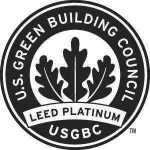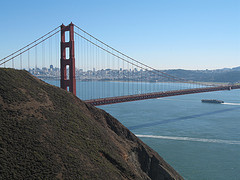The 13 buildings that are highlighted in this post are among the greenest building and renovation projects of recent years. They include Living Building Challenge certified projects (and a couple of projects that are currently pursuing that certification), as well as some of the highest-scoring LEED Platinum certified projects around the world. (Bear in mind that many traditional and indigenous structures were built using more sustainable materials and methods than those that are typically used in these modern times, so many of the world’s greenest buildings were constructed long before the advent of green building certification systems.) The following projects were all built or renovated within the past decade.
Living Building Challenge Projects
 The Living Building Challenge, administered by the International Living Future Institute, is widely recognized as the most rigorous certification system for green buildings; it can also be applied to infrastructure and other types of development projects. It goes beyond most of the LEED requirements. In their own words, “It calls for the creation of building projects at all scales that operate as cleanly, beautifully and efficiently as nature’s architecture. To be certified under the Challenge, projects must meet a series of ambitious performance requirements, including net zero energy, waste and water, over a minimum of 12 months of continuous occupancy.”
The Living Building Challenge, administered by the International Living Future Institute, is widely recognized as the most rigorous certification system for green buildings; it can also be applied to infrastructure and other types of development projects. It goes beyond most of the LEED requirements. In their own words, “It calls for the creation of building projects at all scales that operate as cleanly, beautifully and efficiently as nature’s architecture. To be certified under the Challenge, projects must meet a series of ambitious performance requirements, including net zero energy, waste and water, over a minimum of 12 months of continuous occupancy.”
So far (as of late 2013), t hese are the only four buildings to have achieved the full Living Building certification:
hese are the only four buildings to have achieved the full Living Building certification:
Bertschi School’s Living Building Science Wing
Seattle, WA
More Info
Hawai’i Preparatory Academy’s Energy Lab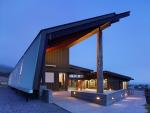
Kamuela, HI
This building also achieved LEED Platinum certification under LEED for Schools v2007.
More Info
Omega Center for Sustainable Living
 Rhinebeck, NY
Rhinebeck, NY
This building also achieved LEED Platinum certification under LEED NC v2.2.
More Info
Tyson Living Learning Center
(at Washington University’s Tyson Research Center)
Eureka, MO
More Info
[February 2014 Update: A fifth building has now achieved the full Living Building certification:
Smith College Environmental Classroom, Northampton, MA]
These two ultra-green buildings have also been completed and their project teams are currently pursuing the Living Building Challenge certification:
Bullitt Center (Bullitt Foundation office building)
Seattle, WA
(Living Building certification pending)
More Info
Phipps Center for Sustainable Landscapes
Pittsburgh, PA
This building achieved LEED Platinum certification under LEED NC v2.2. (Living Building certification pending)
More Info
Top-Scoring LEED Platinum Certified Buildings
So far (as of late 2013), the following projects have achieved the highest scores among all LEED certified projects with the Platinum rating (LEED’s highest rating level). Some are new buildings; some are renovations. And a couple of the projects involve interior spaces (office or store interiors) only.
In the United States
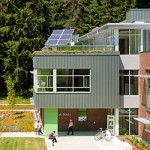 St. Martin’s University, Cebula Hall Engineering Building
St. Martin’s University, Cebula Hall Engineering Building
Lacey, WA
LEED Platinum NC (New Construction) v2009
(97 out of 110 points)
Info
More Info
Integral Group’s Deep Green Office (remodel)
Oakland, CA
LEED Platinum CI (Commercial Interiors) v2009
(102 out of 110 points)
Info
Video Tour
The Bridge Building (historic renovation)
Nashville, TN
LEED Platinum CS (Core & Shell) v2009
(99 out of 110 points)
Info
More Info
502 Second St. NW office building (historic renovation)
Grand Rapids, MI
LEED Platinum NC (New Construction & Major Renovation) v2.2
(66 out of 69 points)
Info
More Info
In other countries
Pixel office building
Carlton, Melbourne, Victoria, Australia
LEED Platinum NC (New Construction) v2009
(105 out of 110 points)
Info
More Info
The Change Initiative store
Dubai, United Arab Emirates
LEED Platinum Retail CI (Commercial Interiors) v2009
(107 out of 110 points)
Info
More Info
ITC Green Centre office building
Gurgaon, Haryana, India
LEED Platinum O&M: EB (Existing Buildings) v2009
(99 out of 110 points)
Info
To see other Platinum projects, check out our listing of LEED Platinum Certified Buildings, Offices, and Homes worldwide.
This post has provided a selected, not a comprehensive, list of super-green buildings. If you know of another completed, ultra-green building that you’d like others to know about, please mention it in the Comments, with a link to information about the project.
Related posts:
LEED Platinum Leaders: January 2012 Update of Top-Ranking States and Countries
Model Sustainable Neighborhoods: LEED ND Developments in the U.S., Canada, and China


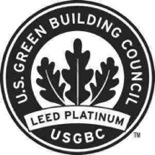 I recently added newly certified Platinum-rated projects (buildings, homes, offices, and stores) to my online listing of
I recently added newly certified Platinum-rated projects (buildings, homes, offices, and stores) to my online listing of 
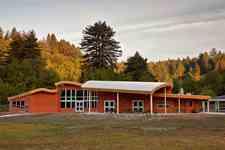 The recently certified Salmon Creek Falls Environmental Center is the first LEED Platinum certified K-12 public school in California, and it is also the first building in Sonoma County to achieve LEED Platinum certification. (The first commercial/non-residential building, that is. I believe that a private residence in Healdsburg was actually the first project to achieve LEED Platinum in Sonoma County.) To the best of my knowledge, the Salmon Creek Falls Environmental Center is the first Platinum rated non-residential building in the entire North Bay region of the Bay Area (Sonoma, Napa, and Marin counties). The Center is located on the site of the
The recently certified Salmon Creek Falls Environmental Center is the first LEED Platinum certified K-12 public school in California, and it is also the first building in Sonoma County to achieve LEED Platinum certification. (The first commercial/non-residential building, that is. I believe that a private residence in Healdsburg was actually the first project to achieve LEED Platinum in Sonoma County.) To the best of my knowledge, the Salmon Creek Falls Environmental Center is the first Platinum rated non-residential building in the entire North Bay region of the Bay Area (Sonoma, Napa, and Marin counties). The Center is located on the site of the  The following are key online resources for information on federal, state, and local environmental tax credits, rebates, and other financial incentives. Most of the incentives that are available are for installing energy-efficient equipment or renewable energy (e.g., solar) technologies.
The following are key online resources for information on federal, state, and local environmental tax credits, rebates, and other financial incentives. Most of the incentives that are available are for installing energy-efficient equipment or renewable energy (e.g., solar) technologies.